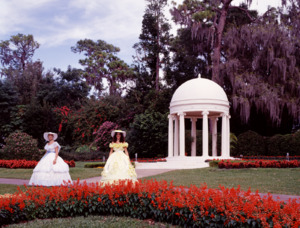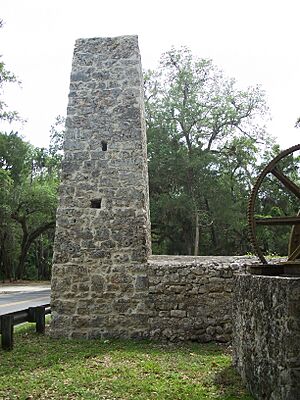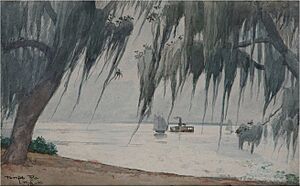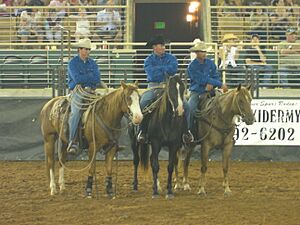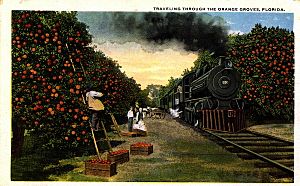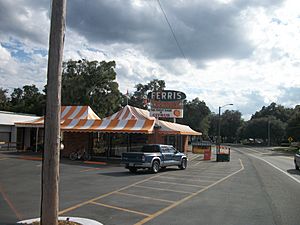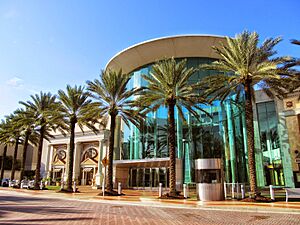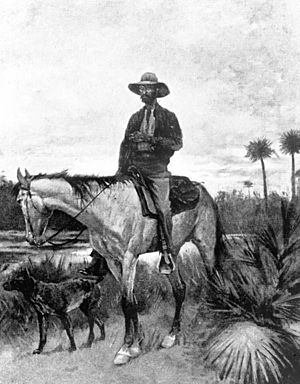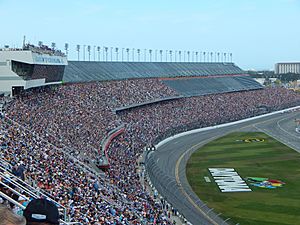Central Florida facts for kids
Quick facts for kids
Central Florida
|
|
|---|---|

Central Florida Images top from bottom, left to right: Orlando Skyline, Daytona International Speedway, Walt Disney World, Kennedy Space Center, Tampa Skyline
|
|
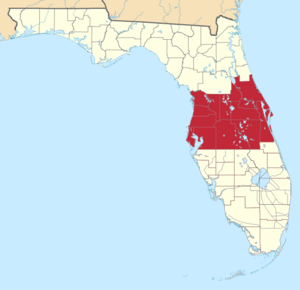
Central Florida, part of the Florida megaregion
|
|
| Country | |
| State | |
| Largest city | |
| Population
(2020)
|
8,359,609 |
Central Florida is a special area in the U.S. state of Florida. It's right in the middle of the state, just like its name says! People sometimes think of it as the area around Tampa Bay and Orlando.
Florida has three main parts: north, central, and south. Central Florida usually includes 13 counties. These are Brevard, Citrus, Hernando, Hillsborough, Lake, Orange, Osceola, Pasco, Pinellas, Polk, Seminole, Sumter, and Volusia. Sometimes, Marion County (where Ocala is) is also included.
Contents
Exploring Central Florida's Geography
Central Florida doesn't have exact borders. Different groups define it in slightly different ways. But generally, it covers a large part of Florida's middle section. This includes the inland areas like Orlando and coastal parts on both the west and east sides.
Central Florida is one of the three main regions in Florida, along with north Florida and south Florida. People often use these names when talking about the middle of the state. Coastal areas sometimes have their own special names, like the Space Coast or the Nature Coast.
The state's business development group, Enterprise Florida, also calls this area "Central Florida." Their definition is similar to what many people think of. It includes the Orlando area (Orange, Lake, Osceola, and Seminole Counties). It also includes Sumter and Polk counties inland. On the west coast, it has Citrus, Hernando, Hillsborough, Pasco, and Pinellas counties. On the east coast, it includes Volusia and Brevard counties.
The main cities of Orlando and Tampa are not far apart, about 85 miles (137 km). Because of this, their two big city areas connect near Lakeland. This creates a large area of people often called the I-4 corridor. This busy area stretches from Tampa Bay on the west coast to Daytona Beach and Cape Canaveral on the east coast.
Most of Central Florida is flat. But there are some hills in places like Mount Dora, southern Lake County, Polk County (Lake Wales Ridge), Pasco County, and Hernando County (Brooksville Ridge). The region has lots of open spaces and over 1,500 lakes and ponds. You'll find wetlands, forests (with Cypress, Oak, Maple, and Pine trees), pastures, prairies, and beautiful coastlines.
Major rivers here include the St. Johns River, Halifax River, Ocklawaha River, and Econlockhatchee River. Important lakes are Lake Apopka, Lake Tohopekaliga, East Lake Tohopekaliga, Lake Louisa, Lake Monroe, Lake Jessup, and the Butler Chain of Lakes. Central Florida has over 100 miles (160 km) of coastline along the Atlantic Ocean. Famous beaches include Canaveral National Seashore, New Smyrna Beach, Daytona Beach, Cocoa Beach, and Indialantic Beach near Melbourne.
Central Florida's Climate and Weather
Hurricanes can be a danger to cities along the coast. For example, in 2004, three big hurricanes hit Central Florida: Charley, Jeanne, and Frances.
Winters in Central Florida are dry and mild. The average high temperature in Orlando during winter is 71 °F (22 °C). The average low is 49 °F (9 °C). Summers are hot and humid. High temperatures average 92 °F (33 °C), and low temperatures average 75 °F (24 °C). The hottest part of summer usually lasts from early June to early October.
Because of the heat, humidity, and winds from both the Gulf and Atlantic coasts, Central Florida has many thunderstorms from June to September. This area gets more lightning strikes than any other part of Florida. In fact, Florida gets more lightning than any other U.S. state! That's why Central Florida is often called the "Thunderstorm Capital of the USA" or "Lightning Alley."
These strong thunderstorms can also cause many tornadoes. However, these tornadoes are usually small and don't last long. They are almost always rated as EF0 or EF1 storms, which are the weakest types.
Central Florida has a subtropical climate. This type of climate is common in most of Florida, except for the very southern part, which has a tropical climate. Unlike South Florida, where it almost never freezes, Central Florida can have freezing temperatures sometimes in winter, though they don't last long. This means that most tropical plants found in South Florida can't grow here. But winters are still much warmer than in most other parts of the United States.
| Climate data for Orlando (Orlando International Airport), Florida (1991-2020 normals, extremes 1952–present) | |||||||||||||
|---|---|---|---|---|---|---|---|---|---|---|---|---|---|
| Month | Jan | Feb | Mar | Apr | May | Jun | Jul | Aug | Sep | Oct | Nov | Dec | Year |
| Record high °F (°C) | 87 (31) |
89 (32) |
93 (34) |
97 (36) |
100 (38) |
100 (38) |
101 (38) |
100 (38) |
98 (37) |
95 (35) |
91 (33) |
90 (32) |
101 (38) |
| Mean maximum °F (°C) | 83.5 (28.6) |
85.5 (29.7) |
88.4 (31.3) |
91.1 (32.8) |
94.5 (34.7) |
96.1 (35.6) |
96.1 (35.6) |
95.4 (35.2) |
93.8 (34.3) |
91.0 (32.8) |
86.7 (30.4) |
83.7 (28.7) |
97.2 (36.2) |
| Mean daily maximum °F (°C) | 71.8 (22.1) |
74.9 (23.8) |
78.9 (26.1) |
83.6 (28.7) |
88.4 (31.3) |
90.8 (32.7) |
92.0 (33.3) |
91.6 (33.1) |
89.6 (32.0) |
84.7 (29.3) |
78.3 (25.7) |
73.8 (23.2) |
83.2 (28.4) |
| Daily mean °F (°C) | 60.6 (15.9) |
63.6 (17.6) |
67.3 (19.6) |
72.2 (22.3) |
77.3 (25.2) |
81.2 (27.3) |
82.6 (28.1) |
82.6 (28.1) |
81.0 (27.2) |
75.5 (24.2) |
68.2 (20.1) |
63.3 (17.4) |
73.0 (22.8) |
| Mean daily minimum °F (°C) | 49.5 (9.7) |
52.4 (11.3) |
55.8 (13.2) |
60.7 (15.9) |
66.3 (19.1) |
71.6 (22.0) |
73.2 (22.9) |
73.7 (23.2) |
72.4 (22.4) |
66.2 (19.0) |
58.2 (14.6) |
52.9 (11.6) |
62.7 (17.1) |
| Mean minimum °F (°C) | 33.2 (0.7) |
36.5 (2.5) |
41.3 (5.2) |
49.2 (9.6) |
58.2 (14.6) |
67.5 (19.7) |
70.5 (21.4) |
70.7 (21.5) |
67.8 (19.9) |
53.4 (11.9) |
44.4 (6.9) |
37.6 (3.1) |
31.3 (−0.4) |
| Record low °F (°C) | 19 (−7) |
26 (−3) |
25 (−4) |
38 (3) |
48 (9) |
53 (12) |
64 (18) |
65 (18) |
57 (14) |
43 (6) |
32 (0) |
20 (−7) |
19 (−7) |
| Average precipitation inches (mm) | 2.48 (63) |
2.04 (52) |
3.03 (77) |
2.58 (66) |
4.02 (102) |
8.05 (204) |
7.46 (189) |
7.69 (195) |
6.37 (162) |
3.46 (88) |
1.79 (45) |
2.48 (63) |
51.45 (1,307) |
| Average precipitation days (≥ 0.01 in) | 7.0 | 6.4 | 6.8 | 6.3 | 8.4 | 16.2 | 17.1 | 17.2 | 14.2 | 8.4 | 6.0 | 7.1 | 121.1 |
| Source: NOAA | |||||||||||||
A Look at Central Florida's History
After the Civil War, much of Central Florida was covered in wetlands. A big project in the 1880s, led by businessman Hamilton Disston, drained these wet areas. This made the land ready for people to settle there.
Sanford became a city in 1877. It was a port where Lake Monroe meets the St. Johns River. Its founder, Henry S. Sanford, hoped it would be a major transportation hub. He even called it "the Gate City of South Florida." It became famous for shipping farm products, earning it the nickname "Celery City."
Kissimmee, first called Allendale, grew quickly in the 1880s. It was the main office for Hamilton Disston's drainage company. The city was an important port for steamships because it was on Lake Tohopekaliga. But when railroads came to Central Florida, the steamship business in Kissimmee was no longer needed.
A very cold period in 1894-1895, called the Great Freeze, destroyed many citrus crops. This had a bad effect on the economy.
The beaches in Volusia County had very hard sand. This made them perfect for car races starting in 1903, before paved roads were common. This is how the area became known for cars and racing. Ormond Beach was a popular place for fast cars. The same beach also led to the creation of a tourist resort by Henry Flagler. Later, John D. Rockefeller, Flagler's former business partner, had a winter home in Ormond.
During and after World War II, the U.S. military built several training bases in the region. These were mainly for planes and later for space travel. In the late 1940s, a missile testing site was set up on Merritt Island near Cape Canaveral. The land was mostly empty, and the good weather allowed for year-round operations. When NASA looked for a place to launch spacecraft in the 1960s, they chose Merritt Island. It was close to the testing site and nearby towns. NASA bought over 100,000 acres (400 km2) of land for the Kennedy Space Center.
Deltona was built in 1962 as a planned community for people retiring. Today, it is the largest city in Volusia County.
The building of the Walt Disney World Resort changed the Orlando area a lot. Walt Disney wanted a place with lots of land that was easy for people from the eastern U.S. to visit. Central Florida had plenty of cheap land. Its inland location also offered some protection from hurricanes. Plans were announced in 1965, and the theme park opened in 1971.
Central Florida's Culture and Lifestyle
Central Florida has its own unique culture. People here often see their area as moderate in politics. This is different from North Florida, which is mostly conservative, and South Florida, which is more liberal.
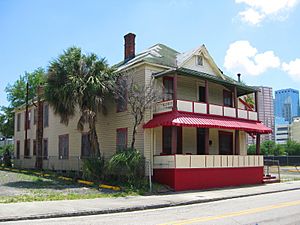
The economy in Central Florida is very similar to South Florida's. Tourism is the biggest industry here. There is also a smaller but important farming industry. This is different from North Florida, which has a wider variety of businesses.
When it comes to food, American cuisine is the most popular in Central Florida. This is like North Florida, but different from South Florida, where ethnic foods are just as popular. For music, Country music is popular in Central and North Florida, but less so in South Florida. Latin music is less popular in Central and North Florida, but very popular in South Florida.
People of Central Florida
In 2009, Central Florida had about 3.3 million people. This count included Orange, Seminole, Osceola, Brevard, Volusia, and Lake Counties. If Polk and Sumter counties were added, the population would be almost 4 million. Central Florida has grown very fast over the last thirty years.
Major Cities in Central Florida
Here are some of the biggest cities in Central Florida, listed by how many people live there:
| City | 2020 population | 2000 population | County |
|---|---|---|---|
| Tampa | 384,959 | 303,447 | Hillsborough |
| Orlando | 307,573 | 185,951 | Orange |
| St. Petersburg | 258,308 | 248,232 | Pinellas |
| Palm Bay | 119,760 | 79,413 | Brevard |
| Clearwater | 117,292 | 108,789 | Pinellas |
| Lakeland | 112,641 | 78,452 | Polk |
| Deltona | 93,692 | 69,543 | Volusia |
| Largo | 82,485 | 69,371 | Pinellas |
| Melbourne | 84,678 | 71,382 | Brevard |
| Kissimmee | 79,226 | 47,814 | Osceola |
| Daytona Beach | 72,647 | 64,112 | Volusia |
| Port Orange | 62,596 | 45,823 | Volusia |
| Sanford | 61,051 | 38,291 | Seminole |
| St. Cloud | 58,964 | 35,183 | Osceola |
| Apopka | 54,873 | 26,642 | Orange |
| Ormond Beach | 43,080 | 36,301 | Volusia |
| Clermont | 43,021 | 9,333 | Lake |
| Oviedo | 40,059 | 26,316 | Seminole |
Central Florida's Economy
Farming has always been a big part of Central Florida's economy. This includes winter strawberries, citrus fruits, timber, vegetables, and raising fish.
Tourism is also a huge part of Central Florida's economy. Many people visit the area for its attractions.
In the last ten years, the area's economy has become more varied. Metro Orlando is now a high-tech industrial center. It has the seventh largest research park in the U.S., called Central Florida Research Park. This park is home to the engineering and business school of the University of Central Florida. Big defense companies like Lockheed Martin and Siemens are also here.
Medical research is important in Tampa at the University of South Florida and in Orlando at the University of Central Florida. The Sanford-Burnham Medical Research Institute also does biomedical research. The University of South Florida is especially good at cancer and dementia research.
The Tampa Bay area has become a hub for high-tech manufacturing and research. Both Orlando and Tampa Bay are also important centers for the financial industry. This includes insurance companies and the back-office operations for large banks.
Central Florida is home to several active military bases. These include Patrick Space Force Base and Cape Canaveral Space Force Station on the Atlantic coast. On the Gulf Coast, there's MacDill Air Force Base, Coast Guard Air Station Clearwater, and Coast Guard Sector St. Petersburg. Inland, you'll find Naval Support Activity Orlando, the Navy Pinecastle Impact (Bombing) Range, and the Avon Park Air Force Range. These bases also host other important military groups.
Other major U.S. Government sites in Central Florida include the Kennedy Space Center. This is a NASA facility next to Cape Canaveral SFS. There are also Department of Veterans Affairs (VA) clinics and hospitals.
Fun Attractions in Central Florida
Theme Parks
Central Florida is famous for its amazing theme parks!
- Walt Disney World Resort includes:
- SeaWorld Orlando
- Universal Orlando Resort includes:
- Universal Studios Florida
- Universal Islands of Adventure
- Universal Volcano Bay
- Busch Gardens Tampa Bay and Adventure Island
- Legoland Florida
- Gatorland
- Fun Spot America Theme Parks
Zoos
There are four main zoos in Central Florida:
- The Central Florida Zoo and Botanical Gardens in Sanford
- The Brevard Zoo in Melbourne
- The animal park at Busch Gardens Tampa Bay
- Lowry Park Zoo in Tampa
Orlando also has two theme parks with animals: Disney's Animal Kingdom and SeaWorld Orlando.
Natural Areas
Central Florida has many beautiful natural places to visit. These include:
- Bok Tower Gardens
- Wekiwa Springs State Park
- Blue Spring State Park
- Rock Springs Run State Reserve
- Canaveral National Seashore
- Merritt Island National Wildlife Refuge
The region also has many recreational trails for jogging, biking, and horseback riding. These trails are still being connected to form a large network. Some major trails are the Cady Way, Cross Seminole, and West Orange Trails. Many of the best beaches in the United States are found in Central Florida.
Getting Around Central Florida
Airports
Central Florida has several large international airports:
- Orlando International Airport
- Daytona Beach International Airport
- Orlando-Sanford International Airport
- Tampa International Airport
- St. Pete-Clearwater International Airport
- Melbourne International Airport
- Leesburg International Airport
- Lakeland Linder International Airport
- Winter Haven's Gilbert Airport
- Space Coast Regional Airport
Seaports
Port Canaveral is located in Cape Canaveral, about 45 minutes east of Orlando. It is a busy port for cruise ships, cargo, and naval vessels. It's considered Orlando's closest seaport for tourists and locals who want to take a cruise with Disney Cruise Lines or Carnival Cruises. There are plans to build a rail and natural gas line directly from the port to Orlando International Airport.
Another important seaport in the region is Port Tampa Bay. It's one of the busiest in Florida and is planning a big expansion to compete globally.
Freeways and Highways
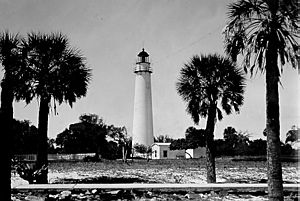
Here are some of the main highways and expressways in Central Florida:
- Interstate 4 (Florida State Road 400)
- Interstate 75 (SR 93 and 93A)
- Interstate 275 (SR 93)
- Interstate 175 (SR 594)
- Interstate 375
- Interstate 95 (SR 9)
- Florida's Turnpike (SR 91)
- Florida State Road 100 – Moody Boulevard
- Florida State Road 528 – Beachline Expressway
- Florida State Road 408 – Holland East/West Expressway
- Florida State Road 417 – Central Florida GreeneWay
- Florida State Road 429 – Western Expressway
- Florida State Road 414 – Apopka Bypass
- Florida State Road 570 – Polk Parkway
- Florida State Road 589 – Veteran's Expressway
- Florida State Road 618 – Selmon Expressway
- U.S. Highway 441
- U.S. Highway 17-92
- U.S. Highway 27
- U.S. Highway 192
- U.S. Highway 1
- U.S. Highway 98
- Florida State Road 19
- Florida State Road 33
- Florida State Road 46
- Florida State Road 415
- Florida State Road 436
- Florida State Road 50
- Florida State Road 60
- Florida State Road 520
- U.S. Highway 41
Public Transportation
Central Florida is building a regional train network for commuters. The first part, SunRail, is a train line that runs from DeLand south to Kissimmee. It was finished in 2014. Amtrak also serves Central Florida, with a stop at the Orlando Amtrak station. The Auto Train stops in Sanford, Florida, north of downtown Orlando.
As of 2022, a fast train between Orlando and Miami is being built by Brightline. They plan to extend this train line to Tampa after it's finished.
Learning in Central Florida
Florida's public schools are managed by the Florida Department of Education.
-
Eckerd College
St. Petersburg -
Florida Institute of Technology
Melbourne -
Saint Leo University
St. Leo -
Florida Southern College
Lakeland -
Florida Polytechnic University Lakeland
-
University of Tampa
Tampa
Images for kids
-
Central Florida Images top from bottom, left to right: Orlando Skyline, Daytona International Speedway, Walt Disney World, Kennedy Space Center, Tampa Skyline
-
The Jackson Rooming House in Tampa welcomed African-Americans during the time of racial segregation. Famous people like Count Basie and Ray Charles stayed here.
-
The historic Egmont Key Light is in Tampa Bay. The island is a National Wildlife Refuge and a state park.
See also
 In Spanish: Florida Central para niños
In Spanish: Florida Central para niños


